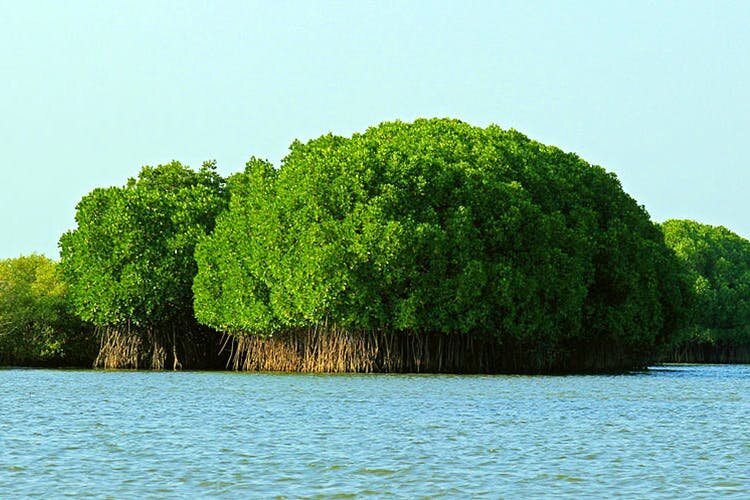Less freshwater inflow into Persian Gulf threatens mangrove forests

TEHRAN – Mangrove forests grow in parts of the Persian Gulf where freshwater enters the saltwater of the sea and a unique ecosystem is created, but for several years due to reduced freshwater inflow, the unbalance between salinity and freshwater has been a threat to the ecosystem.
Mangrove forests are one of the wonders of nature that every time the water goes down, these trees come out like umbrellas, and again with the rising water they go underwater. Southern Iran is one of the most important habitats of these plant species, covered by 22,000 hectares of these forests, of which about 20,000 hectares are located in Hormozgan province alone.
In fact, mangrove forests grow where the freshwater of the river enters the saltwater of the sea, which creates a unique ecosystem, however, dam construction and agricultural development reduced the inflow of freshwater leading to the destruction of the mangroves.
Experts believe that, of course, the drought and the lack of rainfall in the last two decades have paced up the depletion, and all these issues together endangered the lives of these valuable trees.
Southern Iran is one of the most important habitats of these plant species, covered by 22,000 hectares of these forests. Earlier in October, Qasem Taqizadeh, deputy minister of energy for water and wastewater said that Iran’s renewable water resources have decreased from 130 billion cubic meters to about 102 billion cubic meters in less than 30 years, showing a 22 percent decline.
If the current trend continues, the country will lose five billion cubic meters of renewable water resources annually, which means that the water resources will be halved by the next 10 years, he added.
Over the past water year (September 2020- September 2021), the country was 37 percent short of rain compared to the long average in the last 52 years; and water in the reservoirs of 199 national dams has reached a minimum, decreased by about 30 percent.
These statistics show that the country's water resources are not in good condition and need support. Researchers believe that the spread of drought is slow, but its effects may last for years.
Mangrove forests are able to store about 6 to 8 tons of carbon per hectare of soil per year.
Protecting beaches from floods and tsunamis, preventing coastal erosion, supporting the nutrient cycle in water, suitable habitat for plants and animals, producing oxygen due to photosynthesis, providing resin and tannin raw materials, a food source for fish and shrimp, the use of the genes of these trees in biotechnology as genetic resources, medicinal properties, beauty, and natural landscape and tourist attraction are some of the benefits of mangrove forests.
These trees are even of spiritual value and sacred to local communities in some countries, but the question is how successful we have been in protecting them. The statistics show that not only were we not successful, but we have also tried hard to destroy the unique habitat.
Due to the importance of these trees, in 1972, mangrove-covered lands were nationally managed as a protected area.
In 1976, it was accepted and registered as a biosphere reserve. In 1977, the pristine areas of mangrove forests, flower gardens, and streams in the Strait of Khuran were registered as an important wetland of international value (Ramsar site).
The RAMSAR Convention, an international treaty, was adopted in 1971. Ramsar Wetlands are sites inscribed on the List of Wetlands of International Importance (the "Ramsar List") under the Convention on Wetlands.
Experts believe that the acidification of seawater is harmful to marine ecosystems. Because organisms with calcareous skeletons lose their calcareous skeletons in acidic water, they also lose the ability to build skeletons, such as coral reefs and bivalves, but a good feature of mangrove forests is that a series of natural reactions that occur in the soil can naturally increase the percentage of alkalinity in the surrounding water and reduce acidity.
As the seas and oceans become more acidic, the protection of this marine forest ecosystem has received much attention from the world, but the problem is that these forests may be able to moderate the effect of acidification, but up to an extent, so that, a definite solution is required.
Wetlands are important
Wetlands are ecosystems saturated with water, either seasonally or permanently. They store water and ensure its quality, providing resilience against drought. They play a central role in sustainable development by supplying all our freshwater.
Wetlands play a major role in protecting the land against floods and the impacts of storms. They provide food and diverse habitats which support genetic, species, and ecosystem biodiversity. Wetlands play a key role in the life cycles of many species and in annual migration patterns.
Unfortunately, wetlands are being degraded and lost due to pollution, overexploitation, climate change, and human population growth.
FB/MG
